You can see our other Nightmare on Elm Street lists here. Today, it’s time for Freddy’s Dead: The Final Nigthmare (1991), aka, the one with Freddy’s daughter, fake-son, and a bunch of celebrity cameos
New Line was the “House Freddy Built,” but his presence had fed New Line so much capital in such a short time that it no longer really needed him after Nightmare on Elm Street 5: The Dream Child‘s poor box office indicated the well had run dry. They wouldn’t hold Freddy off the screen for a while to re-build interest/anticipation nor would they plunge into a Freddy Vs. Jason film. The slasher genre in general was dying [see: the box office for Jason Takes Manhattan in 1989]. It was time to move on.
[from this point forward, unless otherwise noted all quotes come from Never Sleep Again: The Elm Street Legacy].
1. It wasn’t a marketing ploy – Freddy’s Dead really was supposed to be The Final Friday
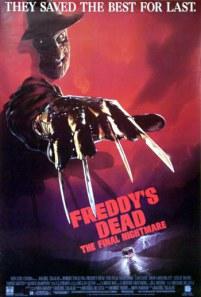
Everyone making Freddy’s Dead thought it was the end of Freddy Krueger just the same way everyone making Friday the 13th: The Final Chapter or Halloween 2 thought they had a front row seat to the final deaths of Jason Vorhees and Michael Myers respectively. Freddy’s Dead actor Ricky Dean Logan even claims the contracts they signed specified that this was to be the final Elm Street film. Little did they know that at that very moment Sean Cunningham was busy re-acquiring the rights to Friday the 13th, and beginning his decade-long quest to get Freddy Vs. Jason made.
2. Peter Jackson wrote an early screenplay featuring an old, decrepit Freddy
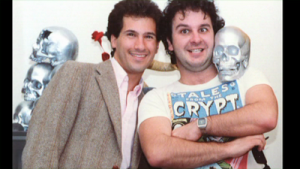
Peter Jackson (right) from his time working on an Elm Street script for New Line
By 1990, Peter Jackson had only directed two small New Zealand films, but New Line’s Mark Ordesky liked what he saw, bringing ckson and writing partner Danny Mulheron aboard to write Nightmare on Elm Street 6: The Dream Lover. Their story made Freddy older, weaker, and decrepit, victim to Elm Street kids who were taking sleeping pills at slumber parties to team up in their dreams and beat the living crap out of the bastard child of a thousand maniacs. The primary conflict would come when the father of one of Freddy’s former tormentors slipped into a coma, thus made subject to Freddy’s torture in a permanent dream world. The stage would be set for a throwdown between Freddy and the son coming to save his father. Though this script went un-produced, it was the moment Jackson got his foot in New Line’s door, beginning a professional relationship culminating with Lord of the Rings and The Hobbit.
3. The director was a woman
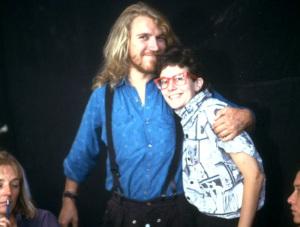
Renny Harlin and Rachel Talalay on the set of Nightmare on Elm Street 4: Dream Master
Freddy’s Dead director Rachel Talalay remains the only female to ever direct a Nightmare on Elm Street film. She had worked in some capacity on Nightmare on Elm Street 1-4, earning official credits as a line producer for 3 and producer for 4. She sat out part 5, working instead on other New Line projects, such as producing John Waters’ Cry Baby (1990). Eager to transition into directing, she lobbied for the job to direct the final Nightmare on Elm Street, penning her own story in the process. New Line decided to go with her, thus abandoning Peter Jackson and his script which in no way resembled Talalay’s proposed story.
4. The original script focused on Alice’s son from The Dream Child, and featured the return of the Dream Warriors as Dream Police. That’s right; you heard me-Dream Police.
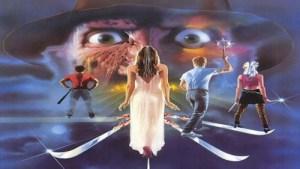
In the script, Kincaid was now “Power Cop,” Joey “Sound Cop,” and Taryn “Blade Cop”
Working from Rachel Talalay’s story, Michael Almereyda’s script killed off Elm Street 4 and 5′s protagonist Alice right away, focusing instead on her now 16-year-old son Jacob, whom Freddy was attempting to use to gain access to children outside of Springwood. Jacob would be assisted in his fight against Freddy by Taryn, Kincaid, and Joey from Dream Warriors, whose souls had been freed from Freddy at the end of Dream Master and were now returned by an unknown force as super-powered regulators known as the “Dream Police.” The problem was that Freddy couldn’t kill them and they couldn’t kill him either, resulting in a semi-climactic epic battle in which the Dream Police and Freddy literally tear each other part only to them re-form for another round of combat. So, it fell upon Jacob and his love interest Karen to defeat Freddy, who was finally bested when Karen discovered Freddy had been raised by an abusive foster father whose form she took to reduce Freddy to a child-like state in the dream world (You can read Almereyda’s full script here).
Rachel Talalay hated (hated!) this script, and New Line power executive Michael De Luca stepped in to write Freddy’s Dead far more faithful to Talalay’s original story. De Luca had similarly performed emergency re-writes on A Nightmare On Elm Street: The Dream Child.
5. They re-used most of the crew from John Waters’ Cry Baby, including Traci Lords’ husband
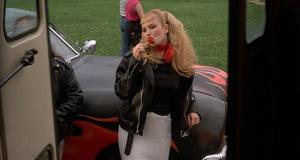
Traci Lords in Cry Baby
Rachel Talalay’s time producing Hairspray for John Waters in 1988 and Cry Baby in 1990 translated to Waters letting her most of his normal film crew for Freddy’s Dead. One such crew member who transitioned to Freddy’s Dead was prop master Brook Yeaton. Interestingly enough, Yeaton was married to Traci Lords at the time, the two having met on the set of Cry Baby, which was only Lords’ second mainstream film after having spent 1984-1987 performing in over 100 adult films before she’d ever turned 18.
6. Johnny Depp didn’t do the cameo because it was the final Elm Street film. He did it as a favor to Rachel Talalay
Rachel Talalay knew Depp from her time producing Cry Baby, and based upon that felt comfortable asking him to come in as a favor for a half day’s work on Freddy’s Dead. Once on set, Talalay’s direction to Depp for how to play the parody of the “This is your brain on drugs” PSA was that “it should be dripping with teen sincerity.”
7. The guy who played Carlos, the hearing impaired kid, was originally supposed to play John Doe
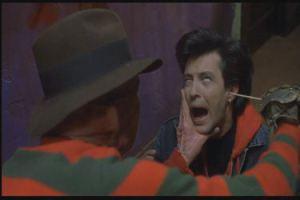
Ricky Dean Logan as Carlos, who actually fought to get to be the guy having that Q-tip shoved in his ear
So, why did Ricky Dean Logan end up playing Carlos instead of John Doe? Because the role of Carlos simply spoke to him more, and that was the one he lobbied for even though that’s not who they had brought him to play. Shon Greenblatt then got the part of John Doe, i.e., the Janet Leight-type we’re meant to think is the lead until he unexpectedly dies halfway through
8. No, they did not have Nintendo’s permission to mock the Power Glove
Nintendo first tried out the more immersive Wii-like video game experience at the tail end of the 1980s with the legendarily shitty Power Glove. Nintendo even produced a Fred Savage film which mostly served as a big commercial for the Power Glove:
So, Nightmare on Elm Street wanted to make fun of that, adding a power glove attachment to Freddy’s glove
Well, according to Rachel Talalay they didn’t actually have permission to do that, “We wanted to use the Power Glove, and Nintendo said no. But [New Line Boss] Bob [Shaye] said, ‘I don’t care what they want. I’m going to use it anyway.’ So, we used it, and it’s great, and it sold more Power Gloves, and Nintendo never sued.”
9. Freddy’s Dead helped Lezlie Dean realize she had repressed memories of molestation

It was surprisingly easy for Lezlie Dean to act out the scenes in which her character, Tracy, descends into a dream in which Freddy takes the form of her father, playing upon her past as a sexually abused girl. However, weeks after filming Lezlie began suffering flashes of memories of molestation in her own real life. Sadly, she had actually really been molested, an experience so traumatic she had repressed those memories. Freddy’s Dead forced those memories to the surface.
10. When Freddy punches Tracy in the face during their epic fight that was really Robert Englund accidentally punching Lezlie Dean
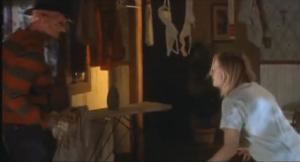
According to Dean, “We were doing the fighting scene, and he went back like that to hit me with his glove. But he actually hit me. I had to go to the hospital, get stitches, get a tetanis shot. So, I have a scar. That scar on me I get to look at every day in the mirror and be reminded of Robert Englund.” Oddly, Englund was a big reason New Line auditioned Dean for the part of Tracy to begin with, since he knew her from his time directing her in 967-EVIL.
11. To promote Freddy’s Dead, New Line held a public funeral for Freddy
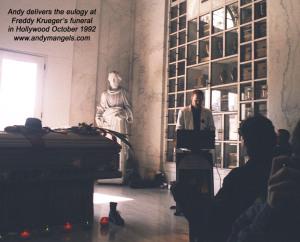
The final 10 minutes being in 3D wasn’t the only gimmick or publicity stunt rolled out for Freddy’s Dead. New Line held a funeral for Freddy Krueger at the Hollywood Forever Cemetary, with the press invited to watch as assorted cast members and production people from Freddy’s Dead and prior Elm Street films mournfully watched over an empty coffin adorned with flowers and Freddy’s hat and shirt.
12. The city of Los Angeles declared September 12, 1991 (the day before the release of Freddy’s Dead) to be “Freddy Krueger Day”
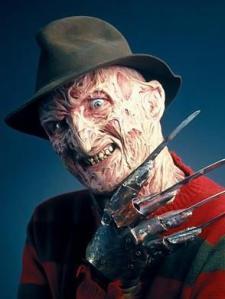
This man had his own local holiday. Not bad for a dead child molester.
It was a way of promoting the city of Los Angeles as well as celebrating Nightmare on Elm Street, which, unlike Friday the 13th, had filmed every franchise entry in Los Angeles, employing plenty of local labor and returning money back into the Los Angeles area.
13. The producer actually had to step in and direct some of the final scenes
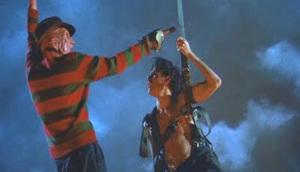
Was Rachel Talalay that bad? Is that why her producer had to direct some scenes? No. Talalay simply got really sick toward the end of their filming schedule, and being a low-budget flick they couldn’t delay production to wait for her return. So, according to Shon Greenblatt, “Aron Warner actually directed the last several hours of the filming of the movie,” including the final scene between Freddy and John Doe.
The final damage
- Body Count: 3
- Box Office: $34.8 million, which would be like making $65.9 million at current ticket prices (i.e., around how much Warm Bodies & Jack the Giant Slayer each made last year). The appeal of 3D and being the final Nightmare on Elm Street allowed Freddy’s Dead to gross $12 million more than Dream Child, which had set a franchise low in domestic gross two years earlier. Among the original Elm Street films, only Dream Warriors and Dream Master posted a higher domestic gross than Freddy’s Dead.
Next time, we’ll answer where the heck Robert Englund disappeared to in the second half of Wes Craven’s New Nightmare.
You can use the following links to check out all of our other “13 Things…” lists: Nightmare on Elm Street, Nightmare on Elm Street 2: Freddy’s Revenge, Nightmare on Elm Street 3: Dream Warriors, Nightmare on Elm Street 4: The Dream Master, Nightmare on Elm Street 5: The Dream Child, Friday the 13th, Part 2, Part 3, The Final Chapter, A New Beginning, Jason Lives, New Blood, Jason Takes Manhattan, Jason Goes to Hell, and Jason X,
Sources: Never Sleep Again: The Elm Street Legacy, NightmareOnElmStreetFilms.com

